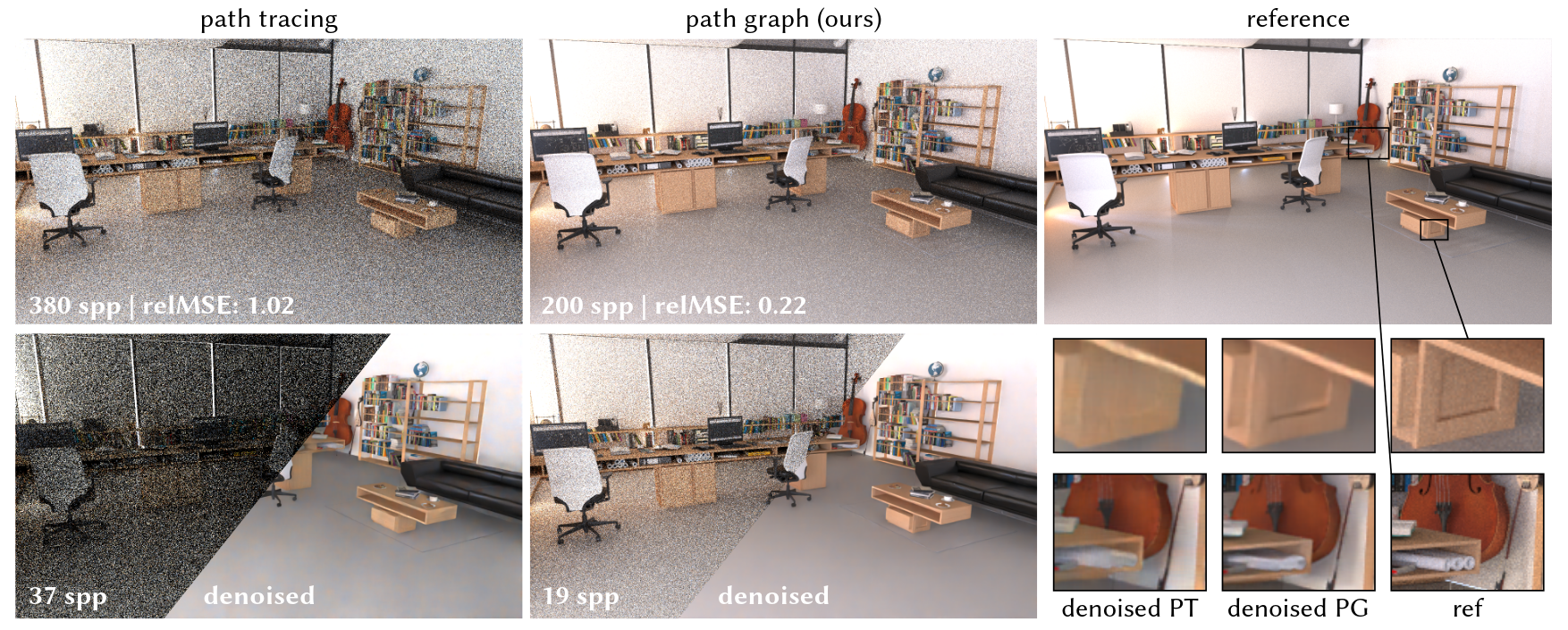Path graphs: iterative path space filtering

Equal-time comparisons showing the improvement provided by the path graph in an indirect illumination-dominated scene. The top row shows a higher sample count; 200 samples processed with the path graph takes less time than path tracing 380 samples without the path graph; noise is reduced substantially. The bottom row shows the results of denoising a lower sample count; 19 path graph passes take less time than 37 samples of path tracing, and the denoised result is markedly improved in resolving details of illumination. Scene: office.
Abstract
To render higher quality images from the samples generated by path trac- ing with a low sample count, we propose a novel path reuse approach that processes a fixed collection of paths to iteratively refine and improve radi- ance estimates throughout the scene. Our method operates on a path graph consisting of the union of the traced paths with additional neighbor edges inserted among clustered nearby vertices. Our approach refines the initial noisy radiance estimates via an aggregation operator, treating vertices within clusters as independent sampling techniques that can be combined using MIS. In a novel step, we also introduce a propagation operator to forward, the refined estimates along the paths to successive bounces. We apply the ag- gregation and propagation operations to the graph iteratively, progressively refining the radiance values, converging to fixed-point radiance estimates with lower variance than the original ones. We also introduce a decorrelation (final gather) step, which uses information already in the graph and is cheap to compute, allowing us to combine the method with standard denoisers. Our approach is lightweight, in the sense that it can be easily plugged into any standard path tracer and neural final image denoiser. Furthermore, it is independent of scene complexity, as the graph size only depends on image resolution and average path depth. We demonstrate that our technique leads to realistic rendering results starting from as low as 1 path per pixel, even in complex indoor scenes dominated by multi-bounce indirect illumination.
Download
Video
Cite
Xi Deng, Miloš Hašan, Nathan Carr, Zexiang Xu, Steve Marschner. Path graphs: iterative path space filtering. ACM Transactions on Graphics (Proceedings of SIGGRAPH), 40(6), Dec 2021.
@article{deng21graph,
author = "Deng, Xi and Hašan, Miloš and Carr, Nathan and Xu, Zexiang, Marschner, Steve",
title = "Path graphs: iterative path space filtering",
journal = "ACM Transactions on Graphics (Proceedings of SIGGRAPH)",
volume = "40",
number = "6",
year = "2021",
month = "dec",
doi = "10.1145/3478513.3480547",
keywords = "Computing methodologies, rendering, ray tracing, global illumination, Monte Carlo, path graph, path space filtering",
abstract = "To render higher quality images from the samples generated by path tracing with a low sample count, we propose a novel path reuse approach that processes a fixed collection of paths to iteratively refine and improve radiance estimates throughout the scene. Our method operates on a \emph{path graph} consisting of the union of the traced paths with additional neighbor edges inserted among clustered nearby vertices. Our approach refines the initial noisy radiance estimates via an aggregation operator, treating vertices within clusters as independent sampling techniques that can be combined using MIS. In a novel step, we also introduce a propagation operator to forward the refined estimates along the paths to successive bounces. We apply the aggregation and propagation operations to the graph iteratively, progressively refining the radiance values, converging to fixed-point radiance estimates with lower variance than the original ones. We also introduce a decorrelation (final gather) step, which uses information already in the graph and is cheap to compute, allowing us to combine the method with standard denoisers. Our approach is lightweight, in the sense that it can be easily plugged into any standard path tracer and neural final image denoiser. Furthermore, it is independent of scene complexity, as the graph size only depends on image resolution and average path depth. We demonstrate that our technique leads to realistic rendering results starting from as low as 1 path per pixel, even in complex indoor scenes dominated by multi-bounce indirect illumination. "
}